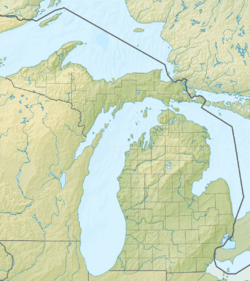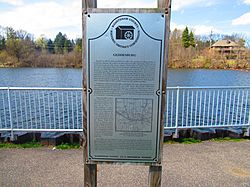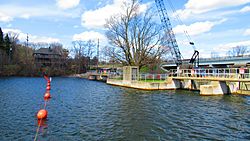Geddes Dam facts for kids
Quick facts for kids Geddes Dam |
|
|---|---|

North section of Geddes Dam in April 2020
|
|
|
Location within the state Michigan
|
|
| Location | Huron River Ann Arbor Township, Michigan |
| Coordinates | 42°16′15″N 83°40′17″W / 42.27092°N 83.67142°W |
| Purpose | Power |
| Status | Decommissioned |
| Opening date | 1919 |
| Owner(s) | City of Ann Arbor |
| Dam and spillways | |
| Type of dam | Barrage |
| Impounds | Huron River |
| Height | 28 feet (8.5 m) |
| Length | 87 feet (26.5 m) |
| Width (crest) | 150 feet (45.7 m) |
| Spillway capacity | 9,700 ft3/s (275 m3/s) |
| Reservoir | |
| Total capacity | 261 acres (105.6 ha) |
The Geddes Dam is a large structure that crosses the Huron River in Ann Arbor Township, Michigan. It was built in 1919 to make electricity from the river's flow. However, it stopped making electricity in 1959. Today, the dam is owned by the city of Ann Arbor. The area around the dam is now a popular spot for outdoor activities, including Gallup Park, which is a favorite place for people in Ann Arbor to visit.
Contents
Where is the Geddes Dam?
The Geddes Dam is located in the southeastern part of Ann Arbor Township. It's about 0.25 miles (0.40 km) from the eastern edge of Ann Arbor city. A major road, U.S. Route 23, crosses the river just west of the dam.
The dam is about 45.5 miles (73.2 km) from where the Huron River flows into Lake Erie. Other dams are nearby: the Argo Dam is 5.0 miles (8.0 km) upstream, and the Superior Dam is 2.5 miles (4.0 km) downstream.
The Geddes Pond
When the Geddes Dam was built, it created a large reservoir (a human-made lake) that covers about 261 acres (106 ha). This reservoir doesn't have an official name, but people often call it the Geddes Pond. It sits about 747 feet (228 m) above sea level. The water in the pond is usually about 16.3 feet (5.0 m) deep.
How the Dam is Built
The Geddes Dam is 28 feet (8.5 m) tall. It has two parts, each with two concrete spillways. Spillways are like gates that let water flow through in a controlled way. The dam is 87 feet (27 m) long, and its top (or crest) is 150 feet (46 m) wide. The dam can release a lot of water, up to 9,700 cubic feet per second (275 m3/s).
Ann Arbor's Dams
The city of Ann Arbor owns four dams on the Huron River. Besides Geddes Dam, they also own the Argo Dam, Barton Dam, and Superior Dam. Only the Argo and Barton dams are actually inside the city limits of Ann Arbor. The Geddes Dam is in Ann Arbor Township, and the Superior Dam is in Superior Township.
History of Geddes Dam
The first time a power plant was built on this part of the Huron River was in 1884. Later, in 1905, the Detroit Edison Company bought land along the river. They planned to build a dam to make electricity.
Building and Changes
The Geddes Dam was finally built in 1919. It was one of several dams built along the Huron River to produce hydroelectricity. However, in 1959, the Geddes Dam stopped being used to make electricity; it was "decommissioned."
In 1963, the Detroit Edison Company sold the dam to the city of Ann Arbor. A few years later, in 1968, a very big storm caused the Geddes Dam to break. This led to high water levels that damaged other dams downstream and caused a lot of property damage. The dam was rebuilt between 1971 and 1972. During this time, new automatic gates were put in to help control the water level in the reservoir.
Electricity Production
The Detroit Edison Company used to run four hydroelectric dams that served Ann Arbor: Argo Dam, Barton Dam, Geddes Dam, and Superior Dam. All of them were stopped from making electricity in the late 1950s. However, the Barton Dam and Superior Dam were started up again in the 1980s. They still provide electricity for Ann Arbor today. The Geddes Dam and Argo Dam were not started up again because it would have cost too much money, and they wouldn't have produced enough energy to make it worthwhile.
In 2010, there was a plan to start the Argo and Geddes dams making electricity again. The idea was to provide power to the nearby Ann Arbor VA Medical Center. A study showed it would cost a lot of money, about $14.7 million, to build new power stations at both dams. The Ann Arbor City Council decided not to fund the project because it was too expensive. They also decided not to completely remove the Geddes Dam. Instead, in 2013, the city approved a plan to improve the areas around both the Argo and Geddes dams. These improvements were completed in 2014.
Fun Activities at Geddes Dam
The Geddes Dam area is a great place for outdoor fun! You can go fishing from the shore both in the reservoir (Geddes Pond) and in the river just below the dam.
What Fish Can You Catch?
Many types of fish live here, including catfish (like bullhead and channel catfish), bluegill, smallmouth and largemouth bass, black crappie, northern pike, and walleye. In the past, tiger muskellunge were put into the Geddes Dam reservoir, but they didn't thrive, so they are no longer stocked there.
Trails and Parks
The Border-to-Border Trail runs right past the Geddes Dam. This trail is 35 miles (56 km) long and goes from Dexter Township to Ypsilanti Township. There are also public facilities along the trail.
The area on the western side of the reservoir is part of Gallup Park. This is Ann Arbor's most popular recreation area. Gallup Park is located on both sides of the reservoir, about 1 mile (1.6 km) upstream from the dam. The Michigan Department of Natural Resources has a small public boat launch at Gallup Park. This allows people to put their boats into the reservoir near Geddes Dam.
Boating Rules
Larger boats are not allowed on the reservoir because it is a "no-wake zone." This means boats must go very slowly to avoid making waves. If you are in a canoe or kayak and want to continue down the Huron River past the dam, you will need to portage your boat. This means taking your boat out of the water and carrying it around the dam to put it back in the river on the other side.
Water Safety Information
Sometimes, the Michigan Department of Health and Human Services issues a "Do Not Eat" fish advisory for the Huron River. This happens when the water has high levels of certain substances, like cyanobacteria or PFOS. When these advisories are in place, it's best to avoid long contact with the water. However, brief contact with PFOS is generally not a health concern. When the advisory is active, fishermen are asked to catch and release their fish. Warning signs are put up at places where people can access the river. These advisories often cover long parts of the Huron River, including the area around the Geddes Dam.




